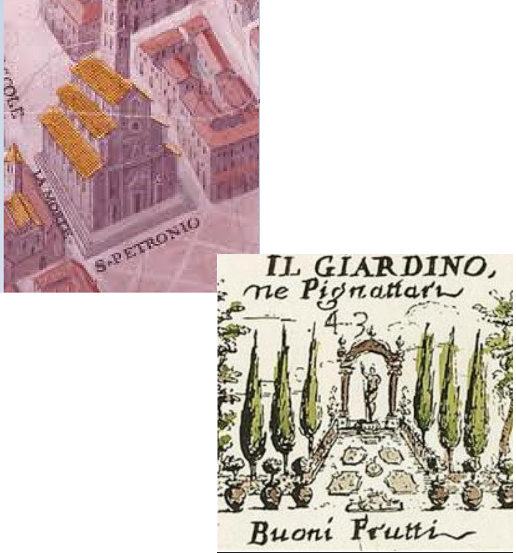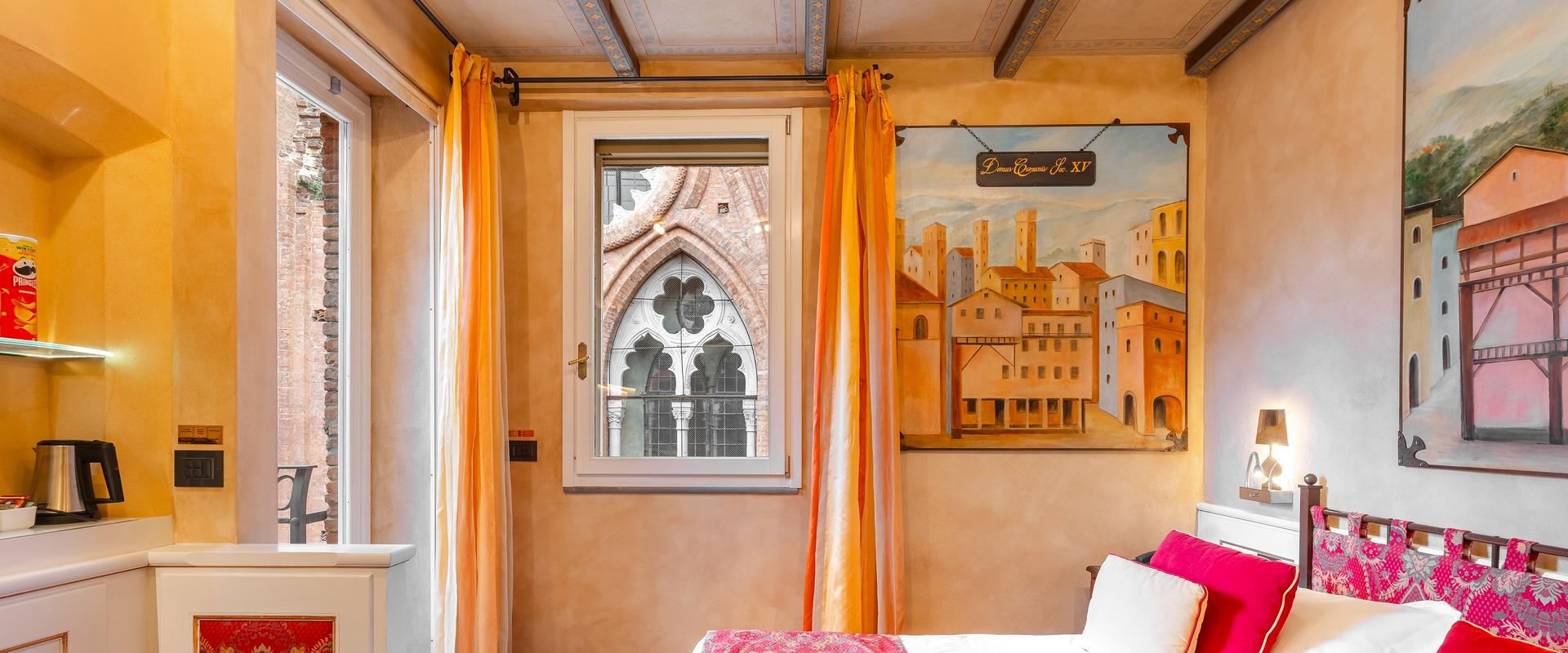Art Hotel Commercianti может похвастаться многовековой историей, тесно связанной с историческим центром Болоньи, который никогда не застывал, а постоянно преображался. Его здания, площади и заведения постоянно перестраивались и реконструировались на протяжении веков, и все же, несмотря на столь долгую историю, город продолжает отражать дух болонцев XVI века. Наша история, согласно историческим свидетельствам, средневековым хроникам и древним документам...
Увлекательно рассматривать историю нашего здания по следам, оставленным прошлыми жителями, каждый из которых на протяжении девяти веков использовал его в качестве резиденции и мастерской, поочередно изменяя и перестраивая под свои цели. Хотя нынешнее воплощение отеля относится к двадцатому веку, изначально он возник как
дом-башня в эпоху Высокого Средневековья, в начале одиннадцатого века, когда подобные укрепленные сооружения строились для противостояния износу и разрушению, а также враждебным действиям со стороны врагов. Даже сегодня, несмотря на многочисленные реконструкции, можно увидеть истоки этой башни: с внешней стороны высокий составной столб и деревянные подпорки портика по-прежнему поддерживают оригинальный фасад, а внутри — почерневшие от древнего пожара балки, которые и по сей день являются неотъемлемой частью всей конструкции здания.
ИСТОРИЯ АРТ-ОТЕЛЯ В ЦЕНТРЕ БОЛОНЬИ
ИСТОРИЯ АРТ-ОТЕЛЯ В ЦЕНТРЕ БОЛОНЬИ
Art Hotel Commercianti... окно в Сан-Петронио...
Наш отель Commercianti признан историческим местом Болоньи, так как находится на одном и том же месте уже более века. Этот сертификат выдан Торговой палатой Болоньи пока только 53 предприятиям в Болонье.


Глубоко вырытый колодец — тот самый, который когда-то снабжал жителей водой во время осад, а фрески, созданные в оригинальной технике segno a chiodo (буквально «следы от гвоздей»), — все, что осталось от пышности и великолепия давно забытых состоятельных семей. То, что мы обнаружили в ходе различных реконструкций, свидетельствует о жизни и деятельности предыдущих обитателей. Горшки рассказывают о скромной жизни семьи в этрусской Фельсине; геометрические фризы и высокий рельеф мифологического животного напоминают о роскоши римской Бононии VIII Реджо-Эмилия; гвозди и железные инструменты, а также статуэтка из терракоты и куски горшков пиньята намекают на скромную работу средневекового кузнеца и торговца посудой. В 1116 году в Болонье образовалась городская Коммуна и новые муниципальные свободы. Для размещения своего Дома Коммуны власти города выбрали Курию Святого Амвросия с прилегающим к ней зданием, в котором мы сегодня находимся.
Однако через шестьдесят три года Дом Коммуны переехал в место, расположенное рядом с библиотекой Archiginnasio, а наше здание, уже не являющееся резиденцией Коммуны Болоньи, было приобретено двумя самыми знаменитыми глоссаторами Болоньи Альберико ди Порта
Тамплиеры, старинные документы кадастра и знамя старой гостиницы...

Но вернемся еще раз в средневековую эпоху и поговорим об Ордене тамплиеров — еще одном прославленном явлении, которое уже давно переплелось с историей нашего здания. Этот рыцарский орден впервые появился в Болонье в 1161 году и вскоре стал одним из самых богатых и влиятельных в городе: его храм мог похвастаться огромными владениями, включавшими сотни акров земли, многочисленные палаццо и здания, а также четыре церкви, в том числе расположенную неподалеку Санта-Кроче на улице Де' Пиньяттари.
Согласно перечню внесенного в кадастр имущества, в каталоге церковной администрации, для паломников был пристроен
некий постоялый двор, который, как нам нравится думать, находился в нашем собственном доме-башне. Но, как это неизбежно происходит со всеми человеческими образованиями, даже почтенный орден тамплиеров начал терять силу и впадать в немилость; в конце концов, в 1312 году папские буллы «Vox in Excelso» и «Ad providam Christi vicarii» распустили орден и лишили его имущества. Церковь Санта-Кроче, переданная религиозному ордену, получившему конфискованное имущество тамплиеров, была впоследствии снесена, чтобы освободить место для строительства Сан-Петронио. Сегодня от церкви не осталось ничего, кроме часовни, возведенной в память о ней внутри базилики. К счастью, другие здания, в том числе и наше, которые были присоединены к Санта-Кроче, ждала другая судьба: благодаря приостановке работ на Сан-Петронио, они смогли сохраниться в неприкосновенности. Еще четыреста лет о нашем здании ничего не упоминается, но в 1712 году оно вновь появляется на гравюре Джузеппе Марии Мители «Новая игра всех таверн Болоньи»: в двенадцатой ячейке изображено знамя сада на улице Де' Пиньяттари (тогда она называлась «della Pellegrina"). Это название было обнаружено в договоре аренды, составленном в 1760 году светским аббатом Маджоне ди Санта-Мария-дель-Темпио.
Последний прыжок в историю приводит нас в начало двадцатого века, когда гостиница превратилась в отель, получив свое название от купцов (commercianti), которые часто посещали важный еженедельный рынок на близлежащей площади Пьяцца Маджоре. Сегодня улица Де' Пиньяттари — тихая пешеходная улочка, но в прошлые века она была шумной проезжей частью. Ее история начиналась как римский декуманус, типичная для римского города дорога с востока на запад (один участок, датируемый 200 годом до н. э., можно найти в начале нашего портика), и со временем на ней появились различные важные учреждения, которые превратили ее в процветающую центральную улицу. В VII веке она называлась Сан-Амброджио и, учитывая ее исключительную для того времени ширину, стала частью площади, на которой она заканчивалась.
Вплоть до XVII века двести метров этой улицы были разделены на три участка с тремя разными названиями в соответствии с близлежащими отраслями промышленности и бизнеса: «Dazi dal vin», «Pignattar» и «Dal Salario». «Dazi dal vin» была компанией носильщиков, также известных как «brentatori» из-за brente (деревянных емкостей для вина), которые они несли. Однако они не были просто носильщиками. Эти brentatori были уполномочены городским советом пробовать вино, определять его цену в зависимости от качества, а затем взимать причитающуюся «пошлину». Участок под названием «Pignattar» был назван в честь гончаров, которые изготавливали терракотовые горшки под названием «pignatte», слово, происходящее от латинского термина «pinnata», а на улице «Dal Salario» располагался соляной склад.

В 1600-х годах эти три части были объединены в одну улицу под названием «Де Пиньяттари», которая, хотя и значительно уменьшилась из-за строительства Сан-Петронио, соединялась с площадью Пьяцца Маджоре. Эта великолепная средневековая площадь к тому времени стала сердцем Болоньи, где собирались жители, чтобы послушать указы и постановления, провозглашаемые с балконов подеста. Площадь и прилегающие к ней улицы были переполнены людьми, ищущими развлечений и дел, и создавали шумную обстановку для многочисленных турниров по фехтованию, фестивалей и зрелищ, которые здесь проводились. И по сей день улица Де'Пиньяттари выгодно отличается близостью к площади Пьяцца Маджоре, тому общему пространству, к которому каждый болонец испытывает чувство собственности и принадлежности. Сегодня на площади проходят самые важные и любимые события города: детский карнавал, трансляция политических выборов на экранах у Подесты, историческая остановка на Mille Miglia (гонка на выносливость на открытых дорогах с участием старинных автомобилей), новогодние праздники с традиционным «vecchione» (чучело, олицетворяющее старый год) и, наконец, бесконечные открытые дебаты, проходящие на Crescentone (слегка приподнятая центральная часть площади).
Болонья известна как «la dotta» («ученая»), «la rossa» («красная») и «la grassa» («жирная»). «Ученая» происходит от Alma Mater Studiorum, престижного университета Болоньи, который был основан в 1063 году и считается старейшим университетом в западном мире. «Жирная» — из-за традиционной болонской кухни, в которой представлены такие пышные блюда, как лазанья, тортеллини, тальятелле аль рагу, мортаделла и боллито. Наконец, «красной» она стала благодаря теплым тонам крыш, фасадов и кирпича терракотового цвета, украшающего средневековый центр, который сохранился в первозданном виде, что делает его одним из самых обширных исторических центров в Италии. Но эти определения и близко не подходят к нашему городу: скорее, Болонья — это образ
жизни. Это ритуал, когда вы едите вкусную еду в траттории и наслаждаетесь хорошей компанией в любимой биассанотами «остерии». Это любовь к музыке всех видов: от исполняемой в театре Комунале оперы до звучащего в тавернах джаза. Это люди, постоянно заполняющие рынки и знаменитые тридцать семь километров аркад и портиков, где расположены лучшие магазины Болоньи. (Кстати, если вам интересно, на болонском диалекте слово «биассанот» означает «тот, кто жует ночь».
И если вы вдруг заблудитесь, спросите «l'albêrg di comerzianti nti Pignatèri», или «Albergo Commercianti in via de Pignattari» на местном диалекте).

В воскресенье, 10 мая 2015 года, арт-отель Art Hotel Commercianti стал главным героем необычного исторического и культурного события.
Наше здание, помимо того, что оно было первым муниципальным зданием Болоньи и резиденцией школы римского права, оказалось первой резиденцией Compagnia dell'Arte dei Brentatori, ремесленной гильдии, родившейся в 1250 году, которой было поручено перевозить и оценивать многие сорта вина. Чтобы подчеркнуть этот кусочек истории нашего города, мы установили памятную табличку перед зданием Art Hotel Commercianti, на том самом месте, где было открыто первое отделение гильдии ремесленников.
В церемонии приняли участие множество важных гостей: Министр окружающей среды и охраны земельных ресурсов Джан Лука Галлетти, советник по экономическим вопросам и продвижению города Маттео Лепоре, генеральный директор Enit Italia Андреа Бабби, заместитель начальника пожарной охраны Марио Принц и другие.

Немного истории о компании Compagnia d'Arte dei Brentatori:
Compagnia dell'Arte dei Brentatori, появившаяся на свет в 1250 году, является одной из старейших ремесленных гильдий и играла ключевую роль во времена Средневековья: благодаря своему огромному опыту ее члены были идеальными судьями для оценки качества вин, которые они перевозили. Они использовали «brente» — большой контейнер, который они надевали на спину. При необходимости Brentatori могли стать пожарными, туша пожары своими «brente».
Compagnia dell'Arte dei Brentatori была юридически признана в 1407 году, и они сохранили ту же государственную службу, что и в 1250 году. Кроме того, они получили особое обязательство перевозить воду на своих «brente» в случае пожара, следуя сигналу колокола башни Асинелли. Резиденция гильдии ремесленников находилась на виа дель Дацио дель Вино, сегодня виа де' Пиньяттари, где расположен наш отель.

